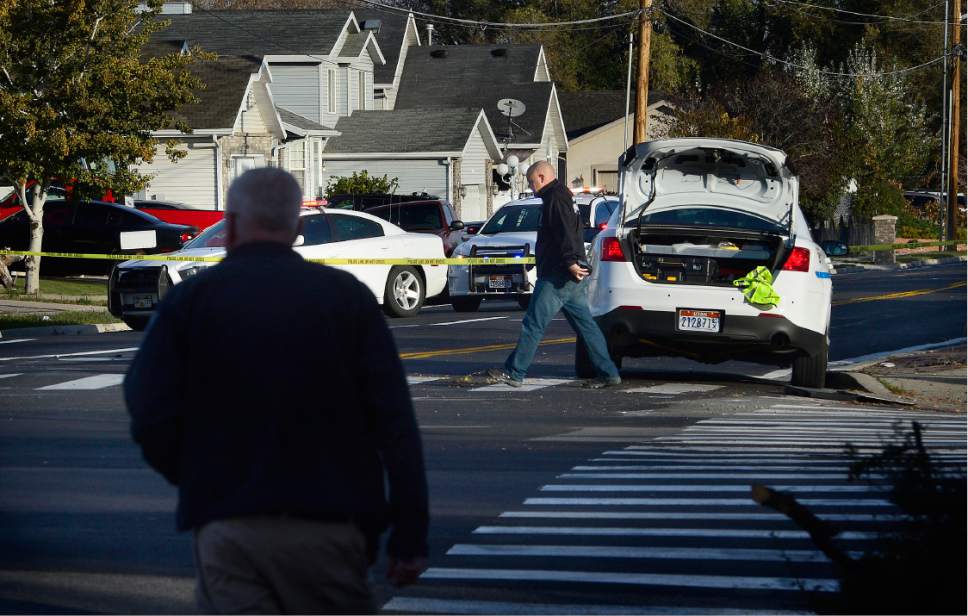This is an archived article that was published on sltrib.com in 2016, and information in the article may be outdated. It is provided only for personal research purposes and may not be reprinted.
A Utah juvenile court judge ruled Thursday that charging documents and other information will be public regarding three teenage boys charged in connection with the death of West Valley City police Officer Cody Brotherson.
Brotherson was killed on Nov. 6, when he was struck by a vehicle believed to be stolen while laying down a set of spike strips.
Two 15-year-old boys and a 14-year-old boy were in the car, police say, and have since been charged with some sort of crime in 3rd District Juvenile Court.
Except for the fact that at least some are felonies, no specifics about the charges have been released because 3rd District Juvenile Court Judge Kimberly Hornak initially granted a motion seeking to have the case sealed from the public. She reversed that decision on Thursday, however, after hearing two days of oral arguments in three separate hearings.
Hornak released her written ruling late Thursday afternoon, and court officials said they expect to release the charging documents Friday morning.
A coalition of Utah's media outlets had asked the judge to unseal the case.
Media attorney Michael O'Brien argued on Tuesday that state legislators intended for these sorts of cases to be open when they crafted a law in the early 1990s that allowed media in the courtroom in serious cases. Today, the law states that a hearing is presumed open if the juvenile is over the age of 14 and charged with what would be a felony-level offense in adult court. The hearing can be closed, however, if a judge finds "good cause" to do so.
"Good cause," however, is not defined in Utah statute — which Hornack had commented was "a little frustrating."
In her written ruling, Hornak determined that good cause did not exist to close the cases. She wrote that closing the proceedings would "be contrary to the intent of the Utah statutes."
Defense attorneys had argued that if the teens' information was released, it would cause embarrassment to their families and could cause anger in the community, according to O'Brien. It also could harm the juveniles if their psychological and personal information were made public, they argued.
Steven Miller, who represents one of the three boys, said in court Wednesday that all of the attorneys and staff involved in juvenile court keep the best interest of the accused youth in mind. The media, he said, does not share that same concern.
Miller said he seldom sees "balanced news coverage of legal battles," adding that he felt the media rarely takes an informational or educational approach, and instead goes for "shock effect."
"This is not the time for untrained and unrestrained, and consequently, insensitive media to make inroads into the juvenile system," he argued.
O'Brien said Wednesday that attorneys for all three juveniles had largely made public policy arguments, and presented little information about how this case is different than any other juvenile court hearing. He said these arguments were settled by lawmakers when they opted to allow media access in serious cases. He called this case the "classic example" of what the legislators intended to be open when they crafted the law.
"The best way to get the objective truth out to the community is through openness," O'Brien argued. "It's not through secrecy. The best way to get that objective truth is for the truth to come from Judge Hornak's courtroom, not through the grapevine."
The charges initially filed against the three boys were misdemeanors, according to Deputy Salt Lake District Attorney Sandi Johnson, so prosecutors initially had no objection to a defense attorney's motion to seal the case.
But Johnson said those charges were then amended to felony offenses against each of the boys. Therefore, the law presumptively allows for media access, Johnson said Wednesday, and prosecutors now had no objection to making the case public. She said they may object in the future if particularly sensitive information is presented.
The Tribune generally does not name juvenile defendants unless they have been certified to stand trial as adults.
On the day of the fatal crash, a chase began just after 3 a.m. on Nov. 6, after police officers saw a silver BMW coupe with Florida plates that had stopped in the middle of an intersection. They saw a group of people walk from the BMW to an apartment complex, and watched the trio get into a Honda Accord and drive away.
The officers tried to stop that vehicle, but the driver punched it on 4100 South, heading west. Officers threw spikes near Redwood Road, but that didn't stop the suspects.
Another police officer told investigators that he could see Brotherson out of his vehicle near 2200 West, trying to put down another set of tire spikes.
"[The officer] observed the Honda Accord swerve towards [Brotherson] and strike him with the vehicle," a detective wrote in a search warrant affidavit. "[The officer] stopped to check on the officer that had been struck. He found Officer Brotherson was down and appeared to be deceased from the impact."
Brotherson was the first West Valley City officer killed in the line of duty since the city was formed in 1980, and is one of three police officers killed on-duty this year. He had been on the police force for three years and left behind a fiancee, two brothers and his parents.



